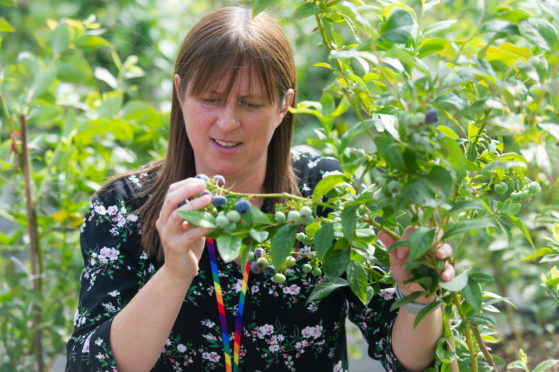A blueberry variety bred specifically for the Scottish climate could be ready for commercial release by the James Hutton Institute (JHI) in just three years’ time.
The soft fruit industry is currently racing to find a large, flavoursome blueberry that is suited to the UK climate, as the £330 million market is growing year-on-year but only 10% is supplied by growers in this country.
Growers attending the JHI Fruit for the Future event at Invergowrie heard that initial results from a breeding programme launched by the institute and three European propagators just 12 months ago are looking “promising” and will be evaluated in the next few days.
Blueberry researcher Dr Susan McCallum said: “Most of the current varieties being released have a lot of Southern heritage in them which gives them good flavour but they are poor for our climate, so we’re trying to breed the climate aspect out of the blueberries into a hardier plant while keeping the taste.
“The trial crops are looking fantastic and we’ve moved 1,200 plants with promising selections into two new tunnels. They have good big fruit, which we have left on the bushes to show off to growers.
“Growers are wanting big fruit to fill the punnets quicker, but you have to have the taste, and in season in the UK the flavour is outstanding and we want to make sure we keep that in the populations we are looking at.”
Researchers are also crossing traditional varieties like the American-bred Chandler, which has big fruit but is a soft variety with poor shelf life, with hardy wild Scottish blaeberries.
Meanwhile JHI’s most promising new primocane and floricane raspberry varieties have been moved into pots in demonstration tunnels to distance them from the root rot problem that’s prevalent in most of the Institute’s ground.
Fruit breeder Dr Nikki Jennings said that while the presence of root rot was an opportunity to screen resistance or tolerance to the disease, it was not ideal when it came to showcasing the Institute’s work.
“It makes it a bit underwhelming for visitors when they come round and see dying plants when we should be showcasing our fruit and new varieties,” she said.
“So we took the best advance selections identified by the breeding consortium away from the breeding plots and put them in a separate tunnel and out of the root rot.
Dr Jennings said pots increase heat to the roots and are portable, so plants can be moved according to conditions. They also reduce the risk of contamination between plots and help prolong the season, thereby potentially lessening the demand for imported fruit.
She added: “I think this will be the catalyst for an overall change in our breeding process — we’re starting to move other selections into pots too. It’s definitely the way forward for our breeding programme offering more flexibility and control.”
nnicolson@thecourier.co.uk







